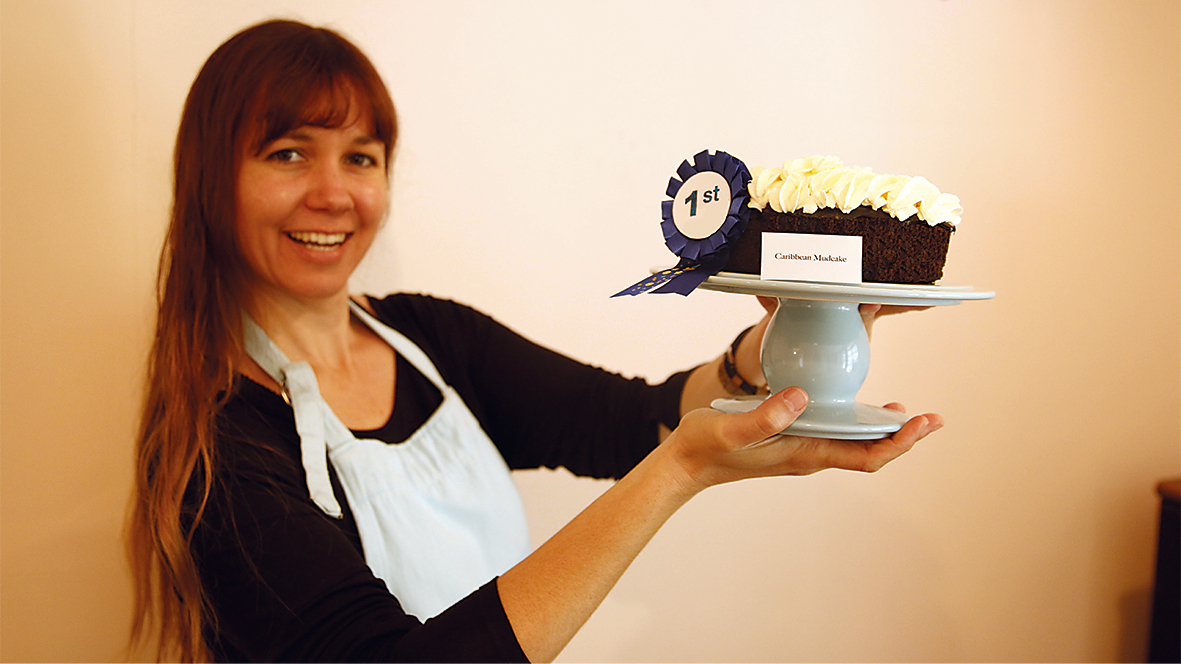A tale of two cakes
February 1, 2019

I could try to convince you that I don’t like cake, but my thighs speak the truth.
I LOVE cake! I love eating it, I love baking it. In my opinion the best thing about birthdays and weddings is the cake! Thankfully, my German mother taught me a thing or two about baked goods, so every time I’m asked to contribute a dish to a shared meal, my mind by default starts dreaming up what cake to bake for the occasion.
It was no different when I was asked to bring a dessert to a church function a few years ago. I was visiting my parents in Western Australia at the time, and my mother had one of those fan-dangled Thermomixes—very powerful hi-tech blenders that can do everything except blow your nose. Mom suggested I make a carrot cake using her Thermomix as it was apparently a very quick process. Feeling adventurous, I chose a carrot cake recipe that included pineapple and coconut, put all the ingredients in the blender, turned it on to mix up the batter, and thought, this’ll take a minute or two; let me quickly duck to the ladies’ room. But being my first time using these machines, I didn’t realise that they work very quickly and very powerfully, so by the time I got back from the bathroom, my batter was smooth as silk, not the usual chunky texture of carrot cake batter. I shrugged and popped the mixture in the oven to bake. But when it came out, I knew there was something seriously amiss. I called in my guinea pigs (Mom, Dad and my brother) and awaited the verdict.
“The texture is wrong. It has all the flavour of a carrot cake, but carrot cake feels different. This is denser, heavier, more mud-cakey.”
Recipe for success
I can’t change the way this cake looks, tastes, its texture, smell, or color—it’s a done deal; I can’t un-bake it, I thought to myself. But what I can change is the perception with which people approach this cake. If they perceive it to be a carrot cake, then they’ll have expectations based on that perception. If they expect it to have a lighter, fluffier crumb with chunks of nuts, perhaps even threads of grated carrot and a sultana or two, then the cake will fail. So perhaps if I remove the label “carrot cake” and give it a new name, I could change their perception entirely—people won’t know they’re eating a dessert disaster!
Taking into consideration the thick new texture and the fact I’d used pineapple and coconut in the recipe, I decided to call it a “Caribbean mudcake.” Sounds exotic, doesn’t it? It wasn’t really; it was just a failed carrot cake!
I took my renamed cake to church next day and dropped it off at the kitchen for safe-keeping.
“Oooh, what’s that you’ve brought, Monica?” “That. . . is a Caribbean mudcake.”
“Monica, did you make this?” “Yes, it’s a Caribbean mudcake.”
I made sure everyone knew this was a Caribbean mudcake, making no mention whatsoever of carrot cake!
People were excited! They’d never heard of Caribbean mudcake before! They couldn’t wait for church to end so they could try a slice! And they loved it! It was so new and tantalizing; flavorsome and velvety! And then the requests started—a friend asked me to make it again for his birthday party. Another asked me to make it as her wedding cake! I couldn’t believe it! A little shift in perception and people were falling over themselves for this cake!
A year later, back in Sydney, I decided to take my perception-altering strategy to the next level; I entered a cake-baking contest using my over-blended carrot cake—I mean, my Caribbean mudcake. The judges’ eyes lit up when they saw the label. New and refreshing, they said. An amazing, innovative combination of flavors! And would you believe it? Pitted against hundreds of other cakes, my cake took home the blue ribbon? How was it that their tastebuds didn’t recognize the age-old flavors of the humble carrot cake?
Is it because what we see depends mainly on what we look for? As science writer Christopher Ray noted, “Perception is merely reality filtered through the prism of your soul.”
At first this discovery of perception altering was revolutionary to me! How else could I control people’s experiences and outcomes based on how I fiddled with their perception? My inner despot momentarily reveled. But then I realized that the easiest perception to change—and the most important—was my own.

Shifting eyes
The other night my friend and I went to a party. We ran into an old school friend, who now has a new wife and baby. The three of us sat around laughing, reminiscing about the good times. His wife would occasionally come into the room and stand at his shoulder and give half-hearted attempts at joining in. Afterwards I remarked to my friend how this woman was clearly threatened by our camaraderie with her husband; hovering at his side, glaring as if to remind us that he was a taken man and we should back off and find our own husbands. My friend was surprised. “I didn’t see that at all. I saw a young mom, exhausted and left out of a conversation filled with ‘you-had-to-be-there’ stories, trying to split herself between being involved in her husband’s previous single life and tending to her 8-month-old baby.”
I was rebuked. I realized that the way I think about a person isn’t always the way they actually are. My friend and I had experienced the same person, but she saw an award-winning Caribbean mudcake and I saw a failed carrot cake.
A quote from American novelist Tom Robbins sums it up nicely: “One has not only an ability to perceive the world but an ability to alter one’s perception of it; more simply, one can change things by the manner in which one looks at them.”
How much sweeter would our own lives be if we chose to perceive others a little more gently? If we were a little more generous than we think is fair when perceiving and presuming about others? If we chose to be sympathetic instead of snide?
“The heart has eyes which the brain knows nothing of,” remarked 19th century preacher and social reformer Charles Henry Pankhurst. His meaning was that we often don’t see things as they are; we see them as we are. Or as Christian writer C.S. Lewis said: “What you see and hear depends a good deal on where you are standing; it also depends on what sort of person you are.”
Are you looking for a failed cake, or mudcake?
Consider the Old Testament story of Job. The Bible tells us he was very wealthy and blessed with a big, happy family and had great health to boot. But in one day he lost everything. His wealth raided and burned, his children dead, his body covered in painful boils. If ever there was a time to look at a situation and perceive only a failed carrot cake, Job had it.
In fact, his friends and wife encouraged him to “curse God and die” (Job 2:9). But through it all, Job stubbornly clung to his faith: “Naked I came from my mother’s womb, and naked I shall depart. The Lord gave and the Lord has taken away; may the name of the Lord be praised” (1:21).
Job refused to let the circumstances engulfing him distort his perception of the God he knew as loving and just and fair. He felt the full pain of his experiences, but he searched for the “Caribbean mudcake”—he trusted God with his perception. He even prayed for his “failed cake” friends whose perceptions need some tweaking!
Our perception of others—our perception of God, too—says a lot about who we are. Who are you? If life turned sour, would you “curse God and die”? Or, like Job, would you choose to trust Him and let Him lead your perception?
Monica Gallasch is a radio broadcaster and award-winning baker, who has more than once re-named a flopped dish and successfully passed it off as meant to be. She writes from Newcastle, Australia, where she co-hosts the FaithFM Breakfast Show.









